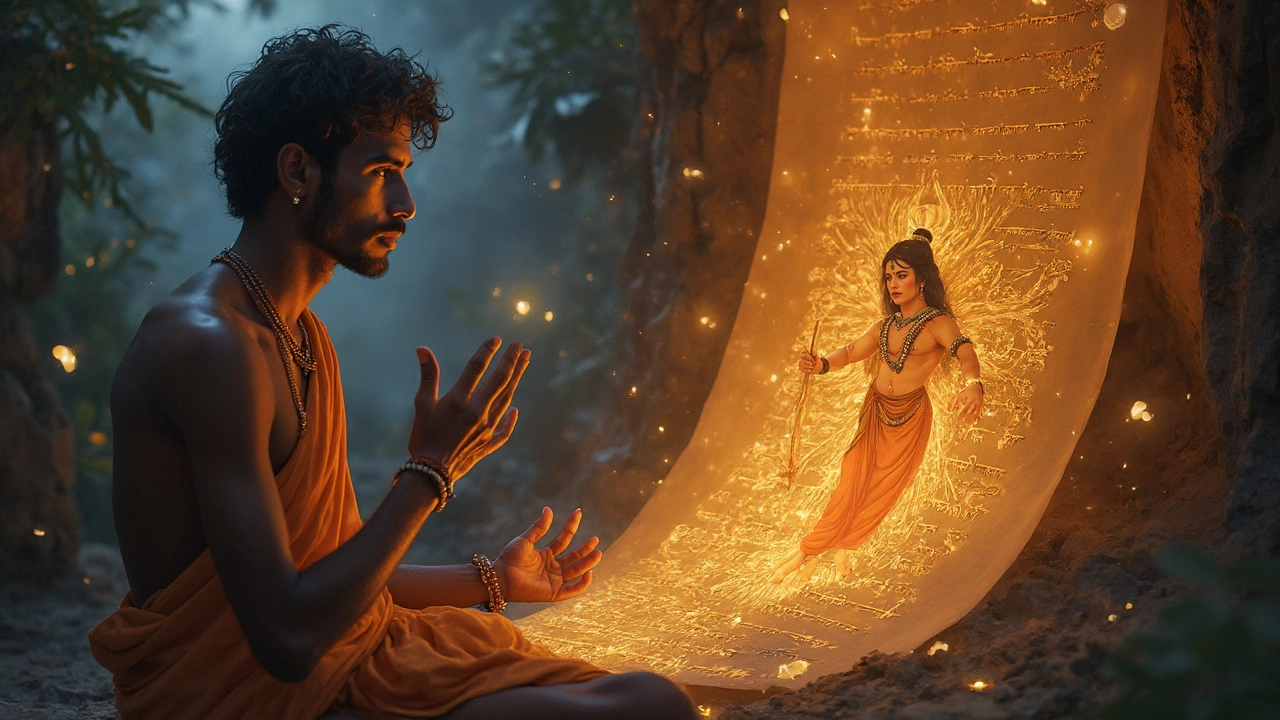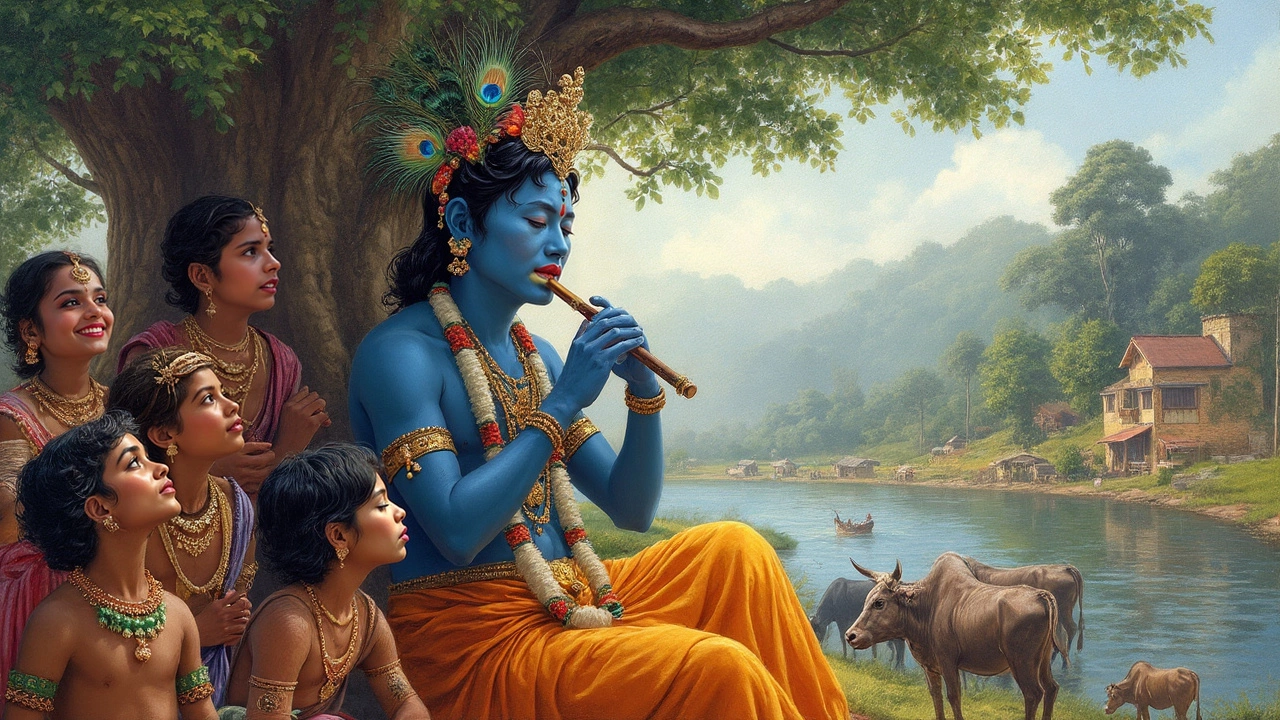Most kids in India, like my son Kanishk, grow up coloring Krishna with blue or black crayons, not really stopping to ask, “Why?” Strangely, even adults just go with it—Krishna is black or blue, and that’s that. But there’s more behind those colors than simple tradition or artistic choice.
Krishna’s name holds a clue: he’s often called ‘Shyam’ (meaning dark or black) and ‘Kanha’ (kind of like ‘the dark one’). In Sanskrit, 'Krishna' itself means dark or black. So, the darkness isn’t just random—it’s built right into his name and story. Ever wondered why ancient poets and artists were obsessed with this one detail, while most other gods are fair or golden? The answer actually tells us a lot about Indian values, culture, and how we see the world around us.
If you’ve ever felt awkward about skin color chats at home (we all have), Krishna’s story is like a slap in the face to old beauty rules. In his world, being black wasn’t a flaw but something special. How did that happen? Let’s break it down—without making it weird or heavy. Trust me, once you get the logic and story behind Krishna’s skin, you’ll never see his photos, movies, or Holi statues the same way again.
- Krishna's Name: What 'Shyam' Really Means
- Stories and Art: How Krishna's Color Became Iconic
- Myths, Rumors, and Scientific Theories
- What Krishna’s Blackness Means for Us Today
Krishna's Name: What 'Shyam' Really Means
Here’s the cool part: Krishna black isn’t just a wild guess or an artistic choice—it’s baked right into his name. 'Krishna' means 'black,' 'dark,' or even 'blue-black' in old Sanskrit. Even his nicknames tell the same story. 'Shyam' literally means 'dark' or 'dusky,' while 'Kanha' is a local dialect twist that means almost the same.
If you dig into the old scriptures like the Mahabharata or the Bhagavata Purana, they refer to Krishna’s skin as 'Shyamavarno'—the one with the dark color. It’s not just poetic either; it's an obvious label, like calling someone 'Redshirt' or 'Tall Guy.' So from the start, everyone knew he stood out for his dark skin.
Wondering why the color was made a big deal? Back then, skin color had no negative vibe. In fact, people saw it as a sign of something special. Dark, in these stories, means mysterious, god-like, and powerful. Crazy, right? The same culture that later fussed about fairness was basically calling its favorite god 'the dark one.'
Let’s look at the names to get it straight:
- Shyam: Often used in devotional songs, it means 'dark-complexioned'.
- Kanha: Used lovingly by Yashoda (his mom), also means 'dark boy'.
- Nila-megha-shyam: This phrase comes up a lot in poetry—comparing Krishna’s skin to dark monsoon clouds.
Here’s a quick reference:
| Name | Meaning | Context Used |
|---|---|---|
| Krishna | Black / Dark | Main name in scriptures |
| Shyam | Dusky / Dark | Bhajans & folk songs |
| Kanha | Dark boy | Personal, regional |
So whenever someone paints Krishna with a black or deep blue color, they’re actually following the old books and stories pretty closely. It’s not just for looks—his color is a big part of who he is and what he stands for.
Stories and Art: How Krishna's Color Became Iconic
Flip through any Indian kids’ comic book, or look at a calendar print in a roadside shop, and you’ll spot Krishna black or deep blue, not looking like anyone in your apartment building. Ever wondered when or why artists started painting Krishna this way? There’s actually a history to it, not just a random paint choice.
The main Sanskrit texts—the Mahabharata and the Bhagavata Purana—call Krishna Shyam and Krishna, words meaning dark, blue-black, or almost the color of a rain cloud. Ancient storytellers weren’t trying to make him stand out as a fancy god. The dark color was written right into his character. Even his childhood bestie—Radha, often shown light-skinned—called Krishna dark and teased him about his looks. Instead of feeling bad, Krishna owned it. That’s interesting, especially since India still has all sorts of hang-ups around skin color.
Artists didn’t all stick with one look, though. Temples in South India show Krishna in black stone. Miniature paintings from Rajasthan are obsessed with that midnight blue shade. Even now, festival statues might be anything from jet-black to bright blue. That dramatic coloring had a simple job: you see a blue or black figure in a scene, you know instantly—ah, that’s Krishna, not just any regular guy. Kind of brilliant from a storytelling point of view.
- From the 16th century, miniature paintings from Rajasthan and Bengal typically showed Krishna with deep blue or black skin.
- South Indian bronze or stone idols from centuries ago are literally carved from black granite to call out Krishna’s famous dark shade.
- Famous writers like Surdas and Jayadeva, in their poetry about Krishna's playful pranks and romances, bring up his black skin over and over—it’s always part of the story.
Here’s something cool: while most gods in Hindu art look similar (same perfect body, same light skin), Krishna almost always looks unique because of his color. He can be surrounded by a crowd, but that skin tone marks him as the main guy every single time. Iconic, right?
Check out this quick comparison of Krishna’s appearance in different art styles:
| Region | Art Style | Krishna's Color |
|---|---|---|
| North India | Miniature Paintings | Blue/Black |
| South India | Temple Sculpture | Black stone |
| Modern Comics | Calendar Art | Electric Blue |
So, Krishna’s color isn’t just a detail—it’s branding. Whether it’s a puja idol, a temple image, or a Netflix series, Krishna black is what makes him instantly recognizable, even for tiny kids like Kanishk. Kind of cool how one color can mean so much.

Myths, Rumors, and Scientific Theories
The whole talk about Krishna’s color gets wild once you dive into the stories people believe, the rumors that go around, and even some modern guesses with a scientific twist. Some say his color was magical. Others try to find ‘scientific reasons’ for it, like he had a rare skin condition or came from a different race. Most of these ideas are creative, but not exactly solid facts.
Let’s get specific. In the Mahabharata and the Bhagavata Purana, Krishna is described as black or dark, but nowhere does it say he had a skin disorder or was painted to look different than everyone else. Some writers say Krishna looked the way he did to stand out—he was unique among the crowd, so people noticed him. His color even symbolized something deeper, like mystery or infinity (think of the night sky—dark, endless, but full of stars).
Now, about the blue thing: ancient artists used blue to show gods were not your average human. Blue wasn’t about an actual skin tone but about being ‘god-level.’ That’s why so many old paintings and modern cartoons show Krishna as bright blue instead of black.
There’s also the rumor mill about Krishna's color coming from genetics or ancient migrations, like the Dravidian or Aryan theories. Modern genetic research on Indian populations doesn’t support the idea that Krishna’s description was literally about race or real DNA differences. The old Sanskrit word ‘Krishna’ simply meant dark—not that complicated.
If you’re curious how all these theories stack up, here’s a quick comparison:
| Theory/Story | Evidence | What it Means |
|---|---|---|
| Skin condition | No ancient text mentions this | Modern rumor, not real |
| Symbolic color | Described in old poems | Meant to show qualities, not appearance |
| God as blue | Seen in art, not stories | Artistic choice to show divinity |
| Race/genetics | No DNA proof, just speculation | Outdated theory |
So, the Krishna black debate is more about what people needed in stories—not science. The art, the words, and the meanings were picked to help people picture something powerful, memorable, and different from their everyday world. And that’s actually way more interesting than any medical mystery.
What Krishna’s Blackness Means for Us Today
This isn’t just an old story for grandma’s bedtime tales—Krishna’s skin color actually hits home even now. If you look at how Krishna black is such a core part of his identity, it’s like a message that says, “Hey, cool is cool no matter the color.” That’s huge in India, where people have made a fuss about fair versus dark forever.
Instead of ducking around the topic, ancient storytellers highlighted Krishna’s darkness. Think about it: he’s celebrated, worshipped, and described as attractive, charming, and smart. No one in the old stories made a big deal about him not being fair. In fact, his skin made him different—and memorable. Sociologist Dr. Shalini Sharma says,
“The color of Krishna challenges India’s own biases and asks fans to judge character, not color.”
If you walk into any Krishna temple or watch any festival like Janmashtami or Holi, you’ll see little kids, teenagers, and even old folks proudly painting themselves blue or black. It’s a rare sight in a country where skin-lightening creams still sell like hotcakes. Looks strange? Yeah, but it’s proof that the Krishna skin color story is actually helping people own what makes them different—not hide it.
Here’s something you can use when those awkward family chats about color start up again:
- Point to Krishna as a role model: If he can be a hero and loved for who he is, so can anyone with any color.
- Know it’s not just myth: Over 42% of Hindu homes have at least one Krishna idol—almost all are dark. No one blinks an eye.
- Art and culture back it up: Painters like Raja Ravi Varma and modern artists never shy away from the blue-black shade.
- Every Janmashtami, millions celebrate the birth of a dark-skinned god—no excuses, no apologies.
Why does this matter? Because kids like Kanishk need real, strong examples from our own stories, not just a boring lecture about “inner beauty.” If we use Krishna's image as a jumping-off point, we can shift beauty talk from comparison to celebration.
